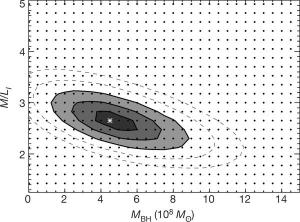Post
It’s a Gas
27 February 2013
Last time I discussed how we can look at the relation between the distribution of stellar speeds in a galaxy and the mass of a galaxy’s central black hole. This relationship is useful because measuring stellar motion in galaxies is fairly hard, and there is a limited number of galaxies for which we have good measurements. For many galaxies the relation between galaxy brightness and black hole mass is all we have to estimate the mass of a galaxies central black hole.
This month in Nature an alternative method was proposed.1 It involves measuring the light emitted by carbon monoxide (CO) in the galaxy. Carbon monoxide is relatively plentiful in the gas nebula of galaxies, and it is relatively easy to identify by its spectrum. Because of this you can also determine whether the gas is moving toward you or away from you by its Doppler shift. Since the nebula of a galaxy move in generally the same manner as the stars, measuring the Doppler shift of CO gives you a measure of the distribution of stars in the galaxy.
 Davis, et al.
Davis, et al.The advantage of this is that measuring the CO spectrum of a galaxy can be done in a matter of hours with the right equipment, so it would be possible to make a survey of black hole masses. The disadvantage of this process is that doesn’t give you the black hole mass directly. Instead you have to fit your data to a model that depends upon the brightness of a galaxy compared to its mass as well as the mass of the central black hole. So basically you run the model lots of times with different values of brightness and black hole mass and see how well the model fits. You can see the result in the figure here, where the research team ran a grid of models with different galactic brightness and black hole masses. The darker the region the better the fit, and the star represents the best fit.
Despite the disadvantages, this approach is much better than using a general relation to estimate black hole mass. As we measure more black holes we will have a better understanding of the dynamics between galaxies and their central black holes, and that will give us a better understanding of galactic evolution.
Davis, Timothy A., et al. “A black-hole mass measurement from molecular gas kinematics in NGC4526.” Nature 494.7437 (2013): 328. ↩︎